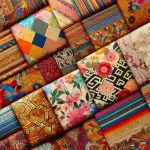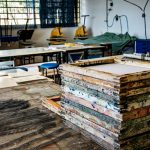Mulberry bark fabric forms the sturdy base of tapa cloth, a traditional textile made by stripping and beating the inner bark of mature mulberry branches. You’ll find this fabric holds cultural significance in Pacific Island communities, symbolizing heritage and identity through its unique patterns and uses in ceremonies. The process requires careful harvesting and rhythmic beating to create smooth, pliable cloth. Keep exploring, and you’ll uncover how this ancient craft blends tradition with modern expression.
Table of Contents
Key Takeaways
- Mulberry bark fabric is made by peeling, soaking, and beating the inner bark of mature mulberry branches into a pliable cloth-like material.
- It has been used for centuries in East Asia and Pacific cultures as a traditional textile before cotton’s popularity.
- Tapa cloth, crafted from mulberry bark, carries deep cultural significance, symbolizing community identity and heritage through unique patterns.
- The fabric is integral in rituals and ceremonies, representing life events and providing spiritual protection with its distinct motifs.
- Modern uses of tapa cloth include fashion, home decor, and art, blending traditional techniques with contemporary design.
Origins of Mulberry Bark Fabric
Although mulberry trees are best known for feeding silkworms, their bark has played a vital role in fabric production for centuries.
Mulberry bark, beyond silkworm sustenance, has been essential in fabric making for centuries.
You might be surprised to learn that mulberry bark was one of the earliest sources of fiber for making cloth, especially in East Asia. People peeled the inner bark carefully, soaked it, and then beat it to create thin sheets of fabric. This technique gave rise to traditional textiles long before cotton became widespread.
When you explore the origins of mulberry bark fabric, you’ll see how various cultures adapted this resource to suit their needs. The durability and flexibility of mulberry bark made it ideal for clothing, ceremonial items, and even paper.
Understanding this history helps you appreciate the unique qualities and enduring legacy of mulberry bark fabrics.
The Mulberry Tree and Its Importance
You’ll notice the mulberry tree stands out with its hardy bark and vibrant leaves, making it ideal for fabric production.
It’s not just a plant; it holds deep cultural significance in many societies, symbolizing growth and resilience.
Understanding these traits helps you appreciate why mulberry bark fabric has such lasting value.
Mulberry Tree Characteristics
When you explore the mulberry tree, you’ll find it’s more than just a source of fabric—it plays an important role in various ecosystems and industries.
The tree grows quickly, with broad, heart-shaped leaves that provide food for silkworms, a key factor in silk production. Mulberry trees adapt well to different climates, thriving in temperate and subtropical regions.
Their bark is thick and fibrous, perfect for making tapa cloth. You’ll notice the tree produces small, sweet berries that attract birds and wildlife, supporting biodiversity.
Mulberries also have deep roots that stabilize soil, preventing erosion. Understanding these characteristics helps you appreciate why the mulberry tree remains crucial not only for crafting bark fabric but also for ecological balance and economic uses worldwide.
Cultural Significance of Mulberry
Because the mulberry tree has supported communities for centuries, its cultural significance runs deep across many societies. You’ll find it not just valued for its fruit, but also revered as a symbol of life, resilience, and craftsmanship. The bark, especially, plays a vital role in traditional textile arts like tapa cloth-making. By using mulberry bark, artisans connect with their heritage and sustain age-old practices.
Here’s a quick look at how the mulberry tree influences culture and craft:
| Cultural Aspect | Importance |
|---|---|
| Symbolism | Life, growth, and resilience |
| Craftsmanship | Bark used in tapa cloth and textiles |
| Economic Value | Source of livelihood for artisans |
| Social Connection | Traditions passed through generations |
You see, mulberry bark fabric is more than material—it’s heritage woven into every thread.
Traditional Methods of Harvesting Bark
When you harvest mulberry bark, you’ll need to use careful stripping techniques to avoid damaging the tree.
Timing is essential, too—traditional methods emphasize harvesting during specific seasons for the best quality fiber.
Let’s explore how these practices work together to produce strong, durable fabric.
Stripping Techniques
Harvesting mulberry bark traditionally involves careful stripping techniques that preserve the tree’s health while yielding quality fibers. When you strip the bark, you want to be gentle and precise to avoid damaging the tree.
Here’s how you typically do it:
- Select mature branches that are at least one year old to guarantee strong fibers.
- Make a shallow cut around the branch’s circumference without cutting too deep into the wood.
- Peel off the outer bark carefully, revealing the inner bark or bast layer used for fabric.
Seasonal Harvest Timing
Although mulberry bark can be gathered throughout the year, knowing the right season guarantees you get the best quality fibers.
Traditionally, the ideal time to harvest is during the early spring or late winter when the sap rises, making the bark more pliable and easier to strip. You’ll want to avoid harvesting in the hot summer months, as the bark tends to be tougher and less flexible then.
When you harvest in the right season, the inner bark separates cleanly from the outer layer, resulting in stronger, smoother fabric. Timing also affects how well the bark responds to soaking and beating, key steps in tapa cloth creation.
Process of Preparing the Bark for Fabric
Before you can transform mulberry bark into fabric, you need to carefully strip the outer layers to access the fibrous inner bark. This step is essential as the quality of the fabric depends on how well you extract these fibers.
Here’s how you do it:
- Peeling: Use a sharp knife or your fingernails to gently remove the rough, outer bark without damaging the inner layers.
- Soaking: Submerge the stripped bark in water for several hours or overnight to soften the fibers, making them easier to work with.
- Cleaning: Rinse the softened bark thoroughly to remove dirt and any remaining outer bark bits, guaranteeing a clean base for fabric preparation.
Following these steps guarantees you get strong, flexible fibers ready for the next stages.
Techniques for Beating and Flattening the Bark
Start by laying the softened mulberry bark on a flat surface, then gently beat it with a wooden mallet or a smooth stone.
This pounding process breaks down the fibers, making the bark pliable and thin. You’ll want to use consistent, rhythmic strikes, working from the center outward to avoid tearing.
As you beat, the bark gradually spreads and flattens, turning into a smooth sheet. If the bark feels too dry or stiff, dampen it slightly to maintain flexibility.
Keep rotating the bark to guarantee even thickness. With patience, you’ll transform the raw bark into a fabric-like material, ready for further use.
Mastering this technique is essential for producing strong, durable mulberry bark fabric.
Decorative Patterns and Symbolism on Tapa Cloth
Once you’ve transformed the mulberry bark into a smooth, pliable fabric, it’s time to add character through decorative patterns.
These designs aren’t just for beauty—they carry deep meanings and stories. When decorating tapa cloth, you’ll often encounter:
- Geometric motifs – Triangles, diamonds, and lines symbolize natural elements like mountains or waves.
- Floral and fauna patterns – These represent local plants and animals, connecting the cloth to its environment.
- Repetitive symbols – Repetition emphasizes harmony, continuity, and cultural values.
As you create or admire these patterns, remember each stroke carries tradition and symbolism, making the fabric a living piece of art.
The patterns vary by region and purpose, so every tapa cloth you see tells a unique story through its decorations.
Cultural Significance Across Pacific Island Communities
You’ll notice mulberry bark fabric plays a key role in rituals, carrying deep symbolism that connects people to their ancestors.
It also helps communities express their unique identities through distinct patterns and uses.
Understanding these meanings lets you appreciate the fabric beyond its physical beauty.
Symbolism in Rituals
Although mulberry bark fabric may seem like a simple material, it holds deep symbolic meaning in many Pacific Island rituals. When you see tapa cloth used in ceremonies, it’s more than decoration—it represents connection, respect, and tradition.
You’ll notice:
- Life Changes: During births, marriages, and funerals, tapa symbolizes the passage from one life stage to another, honoring the person involved.
- Spiritual Protection: The patterns often carry meanings believed to ward off evil spirits or invite blessings.
- Gift-Giving: Presenting tapa fabric shows respect and strengthens social bonds, reflecting generosity and community ties.
Community Identity Expressions
Beyond its role in rituals, mulberry bark fabric serves as a powerful emblem of community identity across Pacific Island cultures. When you see tapa cloth, you’re witnessing a visual language that connects generations and tells stories unique to each island group. You’ll notice distinct patterns and motifs that reflect local heritage, values, and social roles. Communities take pride in crafting and displaying their tapa, reinforcing bonds and preserving cultural memory.
| Island Group | Unique Patterns |
|---|---|
| Tonga | Geometric shapes |
| Samoa | Circular motifs |
| Fiji | Zigzag and diamond |
Tools Used in Tapa Cloth Production
Creating tapa cloth requires a few specialized tools that help transform mulberry bark into soft, wearable fabric.
You’ll need these essential items to work efficiently and produce quality tapa:
- Beating Mallets – These wooden mallets are used to pound the softened bark, spreading and thinning it into a flat sheet. The pounding also helps bond fibers together, creating a durable fabric.
- Anvil or Beating Surface – A sturdy, flat surface supports the bark while you beat it. Traditionally, smooth stone or hardwood blocks serve this purpose to avoid tearing the fibers.
- Stripping Knife – This tool strips the bark from the mulberry tree without damaging the inner layers. It’s vital for harvesting the right bark thickness.
With these tools, you’re ready to start the hands-on process of tapa cloth making.
Variations of Mulberry Bark Fabric in Different Regions
Where can you find the most distinctive styles of mulberry bark fabric? Various Pacific Islands each put their unique spin on tapa cloth, reflecting local culture and environment.
In Tonga, for example, you’ll notice bold geometric patterns with rich red and black dyes. Fiji’s tapa often features intricate, repetitive motifs inspired by nature, like leaves and fish scales.
Samoa stands out with its softer, more delicate designs, sometimes incorporating floral elements. Each region uses specific tools and techniques that influence texture and appearance, so when you handle tapa from different islands, you’re experiencing centuries of tradition and craftsmanship.
Samoa’s tapa features delicate, floral-inspired designs, reflecting unique tools and centuries of craftsmanship across islands.
Understanding these regional variations helps you appreciate how mulberry bark fabric isn’t just one thing—it’s a diverse, living art form shaped by place and people.
Modern Uses and Adaptations of Tapa Cloth
Although tapa cloth originates from ancient traditions, artists and designers today are finding innovative ways to incorporate it into contemporary life. You might notice tapa patterns in unexpected places, blending tradition with modern aesthetics.
Here’s how tapa cloth is evolving:
- Fashion: Designers craft unique clothing pieces, from dresses to accessories, using tapa’s distinctive textures and prints.
- Home Decor: You can find tapa-inspired wall hangings, cushions, and lampshades that add a cultural touch to any space.
- Art Installations: Contemporary artists use tapa cloth in mixed-media works, highlighting its cultural significance while exploring new forms.
Challenges in Preserving Traditional Tapa Craftsmanship
Even with growing interest in tapa cloth, preserving traditional craftsmanship faces significant hurdles.
You’ll find that fewer artisans master the intricate mulberry bark processing and hand-painting techniques, as younger generations often seek different careers. The time-consuming nature of tapa making challenges its viability as a sustainable livelihood.
Additionally, access to quality mulberry trees can be limited by environmental changes and land use shifts, making raw materials harder to source.
You also have to contend with the loss of cultural knowledge when elders pass without passing down skills.
Without strong community support and dedicated programs, traditional methods risk being replaced by mass-produced imitations.
If you want to keep this heritage alive, understanding and addressing these challenges is vital for future generations to appreciate authentic tapa craftsmanship.
Where to Find Authentic Mulberry Bark Fabric Today
If you want to experience the beauty of authentic mulberry bark fabric, you’ll find it primarily through specialized artisans and cultural cooperatives dedicated to traditional tapa-making.
These sources preserve age-old techniques and offer genuine pieces that reflect cultural heritage. To find authentic mulberry bark fabric today, consider these options:
- Cultural markets and festivals – Visit events celebrating Pacific and Southeast Asian crafts where artisans showcase tapa cloth.
- Ethnic craft cooperatives – Support cooperatives in regions like Polynesia or parts of Southeast Asia that produce and sell handmade mulberry bark fabric.
- Online artisan platforms – Look for verified sellers on websites focusing on traditional textiles, ensuring authenticity and fair trade.
Frequently Asked Questions
Can Mulberry Bark Fabric Be Machine Washed?
You might think mulberry bark fabric handles machine washing well, but it’s delicate. You shouldn’t machine wash it; instead, gently hand wash with cold water to keep it intact and avoid damage or shrinking.
Is Tapa Cloth Hypoallergenic?
You’ll find tapa cloth is generally hypoallergenic since it’s made from natural bark fibers without harsh chemicals. However, if you have sensitive skin, it’s best to test a small area first to avoid irritation.
How Durable Is Mulberry Bark Fabric Compared to Cotton?
You’ll find mulberry bark fabric more durable than cotton because its fibers resist wear and tear better. However, it’s stiffer and less flexible, so while it lasts longer, it might not feel as soft or comfy.
Can Mulberry Bark Fabric Be Dyed With Synthetic Colors?
Did you know 90% of mulberry bark fabric accepts synthetic dyes well? You can easily dye it with synthetic colors, giving you vibrant, long-lasting hues that brighten your projects without sacrificing the fabric’s natural texture or strength.
Is Tapa Cloth Suitable for Modern Fashion Design?
You’ll find tapa cloth’s unique texture and eco-friendly nature perfect for modern fashion. It adds cultural richness and sustainability to your designs, though you might need to combine it with other fabrics for durability and versatility.
- Can You Iron Nonwoven Fabric? A Safety Guide - July 11, 2025
- Exploring the Strength and Durability of Nonwoven Fabrics - July 11, 2025
- The Role of Nonwoven Geotextiles in Soil Stabilization - July 11, 2025







